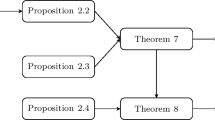Abstract
We extend a well-known theorem of Murskiǐ to the probability space of finite models of a system \({\mathcal {M}} \) of identities of a strong idempotent linear Maltsev condition. We characterize the models of \({\mathcal {M}} \) in a way that can be easily turned into an algorithm for producing random finite models of \({\mathcal {M}} \), and we prove that under mild restrictions on \({\mathcal {M}} \), a random finite model of \({\mathcal {M}} \) is almost surely idemprimal. This implies that even if such an \({\mathcal {M}} \) is distinguishable from another idempotent linear Maltsev condition by a finite model \(\mathbf {A}\) of \({\mathcal {M}} \), a random search for a finite model \(\mathbf {A}\) of \({\mathcal {M}} \) with this property will almost surely fail.
Similar content being viewed by others
References
Baker, K.A., Pixley, A.F.: Polynomial interpolation and the Chinese remainder theorem for algebraic systems. Math. Z. 143(2), 165–174 (1975)
Barto, L., Kozik, M., Maróti, M., McKenzie, R., Niven, T.: Congruence modularity implies cyclic terms for finite algebras. Algebra Universalis 61(3–4), 365–380 (2009)
Bergman, C.: Universal Algebra. Fundamentals and Selected Topics. Pure and Applied Mathematics, vol. 301. CRC Press, Boca Raton (2012)
Berman, J., Idziak, P., Marković, P., McKenzie, R., Valeriote, M., Willard, R.: Varieties with few subalgebras of powers. Trans. Am. Math. Soc. 362(3), 1445–1473 (2010)
Day, A.: A characterization of modularity for congruence lattices of algebras. Can. Math. Bull. 12, 167–173 (1969)
Freese, R.: On the two kinds of probability in algebra. Algebra Universalis 27(1), 70–79 (1990)
Gumm, H.-P.: Congruence modularity is permutability composed with distributivity. Arch. Math. (Basel) 36(6), 569–576 (1981)
Hagemann, J., Mitschke, A.: On \(n\)-permutable congruences. Algebra Universalis 3(1), 8–12 (1973)
Hobby, D., McKenzie, R.: The structure of finite algebras. In: Contemporary Mathematics, vol. 76. American Mathematical Society, Providence (1988)
Huhn, A.P.: Weakly distributive lattices (1972) (preprint)
Jónsson, B.: Algebras whose congruence lattices are distributive. Math. Scand. 21, 110–121 (1967)
Kearnes, K.A., Kiss, E.W.: The shape of congruence lattices. Mem. Am. Math. Soc. 222(1046), viii+169 (2013)
Kearnes, K., Kiss, E., Szendrei, Á.: Growth rates of finite algebras. I: pointed cube terms. J. Austral. Math. Soc. 101, 56–94 (2016)
Kearnes, K., Marković, P., McKenzie, R.: Optimal strong Mal’cev conditions for omitting type 1 in locally finite varieties. Algebra Universalis 72(1), 91–100 (2014)
Kearnes, K.A., Szendrei, Á.: Clones of algebras with parallelogram terms. Int. J. Algebra Comput. 22(1), 1250005 (2012)
Kelly, D.: Basic equations: word problems and Mal’cev conditions. Abstract 701-08-04. Not. Am. Math. Soc. 20, A-54 (1972)
Mal’cev, A.I.: On the general theory of algebraic systems. Mat. Sb. N.S. 35(77), 3–20 (1954)
Maróti, M., McKenzie, R.: Existence theorems for weakly symmetric operations. Algebra Universalis 59(3–4), 463–489 (2008)
Murskiǐ, V.L.: The existence of a finite basis of identities, and other properties of almost all finite algebras. Probl. Kibern. 30, 43–56 (1975)
Olšák, M.: The weakest nontrivial idempotent equations. Bull. Lond. Math. Soc. 49(6), 1028–1047 (2017)
Pixley, A.F.: Distributivity and permutability of congruence relations in equational classes of algebras. Proc. Am. Math. Soc. 14, 105–109 (1963)
Pixley, A.F.: The ternary discriminator function in universal algebra. Math. Ann. 191, 167–180 (1971)
Siggers, M.H.: A strong Mal’cev condition for locally finite varieties omitting the unary type. Algebra Universalis 64(1–2), 15–20 (2010)
Świerczkowski, S.: Algebras which are independently generated by every \(n\) elements. Fund. Math. 49, 93–104 (1960–61)
Szendrei, Á.: Idempotent algebras with restrictions on subalgebras. Acta. Sci. Math. (Szeged) 51, 251–268 (1987)
Author information
Authors and Affiliations
Corresponding author
Additional information
Presented by W. DeMeo.
Dedicated to Ralph Freese, Bill Lampe, and J.B. Nation.
Publisher's Note
Springer Nature remains neutral with regard to jurisdictional claims in published maps and institutional affiliations.
This article is part of the topical collection “Algebras and Lattices in Hawaii”.
This material is based upon work supported by the National Science Foundation Grant nos. DMS 1500218 and DMS 1500254. The second author acknowledges the support of the Hungarian National Foundation for Scientific Research (OTKA) Grant no. K115518.
Appendix A. Proof of Lemma 4.4
Appendix A. Proof of Lemma 4.4
Let \(\zeta _n(k)\) denote the k-th summand on the left hand side in (4.5), that is,
Or goal is to prove that
Claim A.1
For arbitrary constants \(0<u<v<1\) we have that
Proof of Claim A.1
For \(un\le k\le vn\),
Since \((\sqrt{v})^{u(un-1)}<\frac{1}{3}\) for large enough n, we get that
\(\square \)
To establish (A.1), it remains to find u, v with \(0<u<v<1\) such that
This will be accomplished in Claims A.2 and A.3 below.
Claim A.2
For \(u=\frac{1}{2}\) we have that \(\displaystyle \lim \nolimits _{n\rightarrow \infty }\sum \nolimits _{4\le k< un}\zeta _n(k)= 0. \)
Proof of Claim A.2
The following estimates show that the sequence \(\zeta _n(k)\) (\(k=4,5,\ldots \)) is decreasing for \(4\le k\le \frac{1}{2}n\):
The first term of the sequence is
hence
\(\square \)
Claim A.3
There exists a constant v with \(\frac{1}{2}<v<1\) such that
Proof of Claim A.3
As in the proof of [3, Lemma 6.22C], letting \(\ell :=\lfloor vn\rfloor \) we have that
Now let k be such that \((\frac{n}{2}<)\,vn<k<n\). We may assume without loss of generality that \(n>8\), so \(k\ge 4\), and hence \(\left( {\begin{array}{c}k\\ 2\end{array}}\right) \ge \frac{k^2}{3}\). Thus,
Since \(k\ge vn\ge \ell \) and \(vn>\frac{n}{2}\), it follows that \(\left( {\begin{array}{c}n\\ k\end{array}}\right) \le \left( {\begin{array}{c}n\\ \ell \end{array}}\right) \). Therefore, by combining the previous estimates we obtain that
Let \(w(v):=\Bigl (v-\frac{1}{16}\Bigr )^{v}\Bigl (1-v\Bigr )^{1-v}e^{\frac{v^2}{3}}\). Since \(\lim _{v\rightarrow 1}w(v)=\frac{15}{16}e^{1/3}>1\), there exists v with \(\frac{1}{2}<v<1\) such that \(w(v)>1\); for example, \(v=.95\) works. For any such choice of v,
\(\square \)
This completes the proof of Lemma 4.4.
Rights and permissions
About this article
Cite this article
Bergman, C., Szendrei, Á. Random models of idempotent linear Maltsev conditions. I. Idemprimality. Algebra Univers. 81, 9 (2020). https://doi.org/10.1007/s00012-019-0636-y
Received:
Accepted:
Published:
DOI: https://doi.org/10.1007/s00012-019-0636-y



